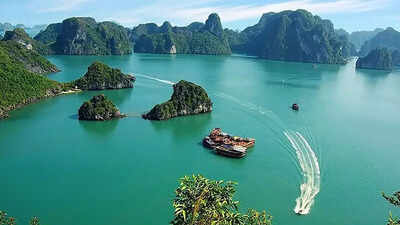- News
- Education News
- Learning with TOI News
- Unveiling the enigmatic origins of Ha Long Bay: A natural marvel of Vietnam
Trending
This story is from October 21, 2023
Unveiling the enigmatic origins of Ha Long Bay: A natural marvel of Vietnam
Nestled within the Quang Ninh Province, Ha Long Bay is a tale of multiple cities - it shares its charm with both Ha Long City and Cam Pha City. However, its official jurisdiction falls under the district of Van Don. This geographical marvel, with its unique natural formations, stands as an exotic wonder, a testament to Vietnam's captivating allure.

Representational
Think of Ha Long Bay, for instance.
How was Ha Long Bay formed?
Before delving into the formation of this bay, let's figure out what karsts are. Karsts are unique land formations, often adorned with an intricate network of caves, sculpted by the gradual erosion of limestone through subterranean watercourses. And now, enter Ha Long Bay, a truly exceptional wonder on a global scale. This natural masterpiece is the world's inaugural and most extensive manifestation of karsts, showcasing over 3,000 of these limestone structures, each with its distinctive shape and size.
Over time, Ha Long Bay underwent a transformation, evolving into a captivating island that now graces us as a breathtaking bay. As you cast your gaze upon an image of Ha Long Bay, you'll be transported to a realm where it seems to emerge like a splendid jewel from the depths of an emerald sea. In actuality, it stands at the centre of two other magnificent bays in the vicinity: Bai Tu Long Bay extending to the northeast and the enchanting Cat Ba Island adorning the southwestern horizon.
According to experts, the mesmerizing karsts and isles dotting the landscape are the remarkable result of ever-changing geographical conditions spanning a staggering 500 million years. As the climate gradually transitioned into a tropical, moisture-rich environment, these geological wonders flourished. Ha Long Bay, in particular, stands as the quintessential example of the Earth's original limestone karst formations.
Interestingly, the narrative of this region extends beyond karst formations, as it bears the imprints of volcanic activities. During these volcanic episodes, carbonate sediments left behind by marine life such as corals, fishes, and other aquatic creatures accumulated. These deposits eventually coalesced to shape the bay that we know today, rich in silica, phosphate, petroleum, lignite, quartz, and hydrothermal mercury.
As for the prominent karstic landforms that you’ll notice on Ha Long Bay, they encompass the elegant cone-shaped hills, or fengcong, the towering limestone karst towers known as fenglin, and the remnants of karstic caves. Observation by geologists reveals that Ha Long Bay did not come into existence all at once. Rather, it is the complex outcome of five cycles of interwoven marine and continental evolution.
Story behind the name
Curious about the meaning of "Ha Long"? It translates to "descending dragon." As you might surmise, this name comes with a captivating tale woven through the fabric of time.
Legend has it that Vietnam once faced incessant threats from foreign invaders. Vietnamese mythology suggests that the Gods dispatched a squadron of benevolent dragons to safeguard the land from potential adversaries. These mighty dragons had the remarkable ability to conjure precious jewels and jade, fashioning an impregnable shield against any looming threats.
But here's where the narrative takes an interesting turn. These dragons possessed the extraordinary power to summon forth colossal rock mountains from the heavens, thwarting the advances of rival ships attempting to infiltrate Vietnamese territory. Over time, as these valiant dragons emerged victorious in numerous battles fought in defense of Vietnam, they chose to stay back on Earth.
The place where the leader or mother dragon descended became known as Ha Long, while the offspring found their abode in Bai Tu Long and indulged in leisurely pursuits on Cat Ba Island. Interestingly, it was only in the late 19th century that Ha Long truly came to the forefront of attention, all thanks to the explorations of intrepid French adventurers.
Flora & Fauna
If you ever visit Ha Long Bay, you’ll meet a vibrant array of marine and terrestrial creatures including 14 unique floral species exclusive to this extraordinary environment and 60 endemic fauna species found nowhere else on Earth.
Among the captivating residents of this ecological wonderland are the mischievous monkeys, the pearl-bearing oysters, the elusive cuttlefishes, the resplendent magnolia flower, the tenacious salt marshes, the gallant fighting cocks, and the diminutive bantams, each playing a unique role in the intricate web of life within Ha Long Bay.
(This content is generated with the assistance of Artificial Intelligence)
End of Article
FOLLOW US ON SOCIAL MEDIA










